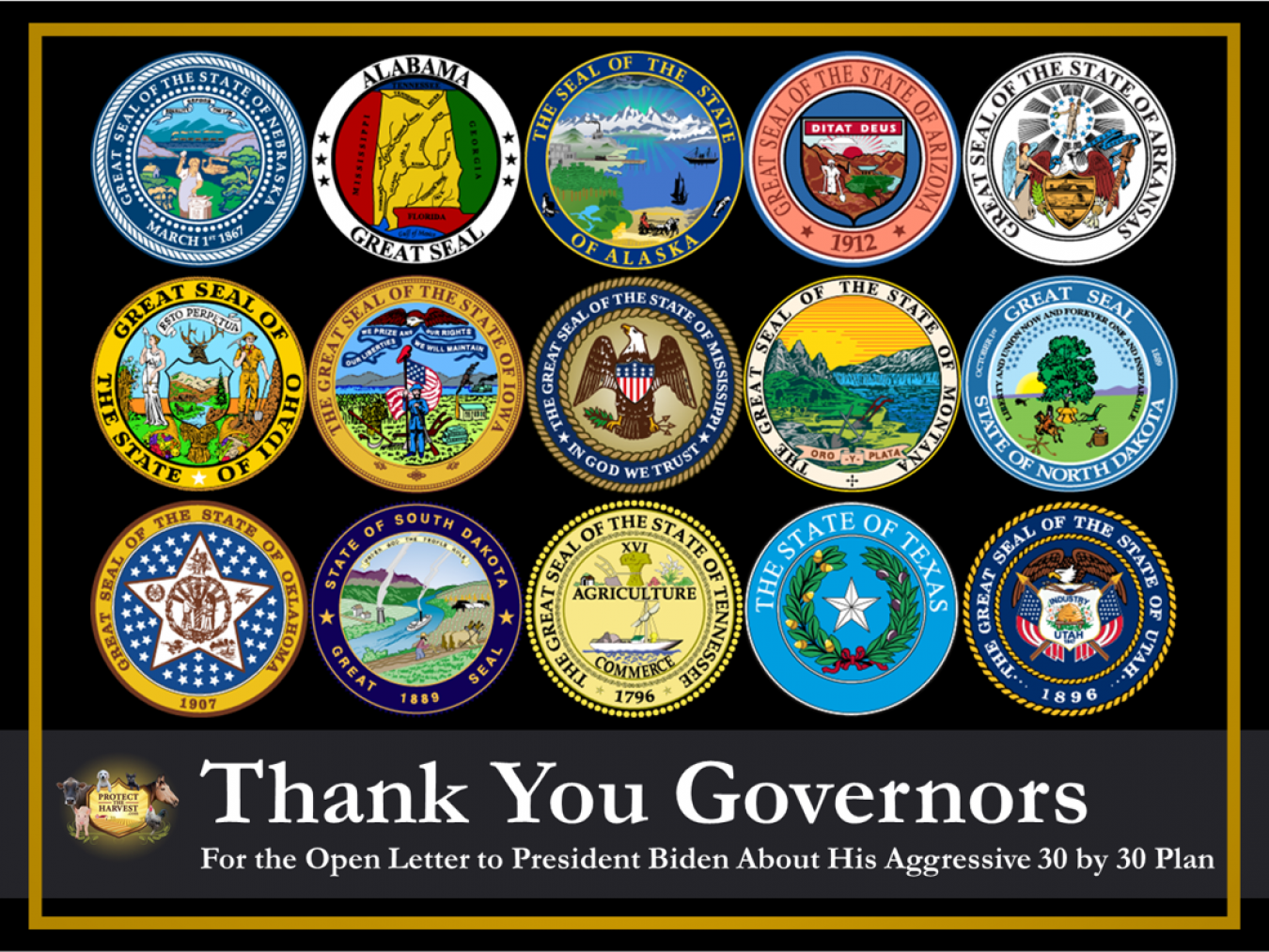
On April 21st, 2021, fifteen State Governors signed an open letter to President Biden voicing their concerns with his aggressive plan, titled, “30 by 30”, which would set aside and permanently conserve 30 % of all land and water in the United States.
We thank these Governors for standing up for American property rights and values
April 21, 2021
President Joseph R. Biden, Jr. The White House Washington D.C. 20500
Dear Mr. President,
On January 27, 2021, your Administration issued Executive Order 14008 (“Order”), “Tackling the Climate Crisis at Home and Abroad” (86 Fed. Reg. 7,619). Included at Section 216 of the Order, the Secretary of the Interior, in consultation with the Secretary of Agriculture and other senior officials, was directed to develop a program to conserve at least 30 percent of the lands and waters in the United States by 2030.
The undersigned are not aware of any constitutional or statutory authority for the President, the
U.S. Department of the Interior, the U.S. Department of Agriculture, or any other federal agency to set aside and permanently conserve 30 percent of all land and water in the United States, and no authority is referenced in Executive Order 14008.
While the Order does not identify which lands may be targeted by the program, the Department of Interior released a fact sheet on the same day finding that only 12 percent of America’s lands are currently “conserved,” the level of restriction, it appears, your Administration is seeking under the new policy. Included in the figure are Wilderness lands, National Parks, National Wildlife Refuges, State Parks, National Monuments, and private lands with permanent conservation easements.
Some of us govern western states with massive amounts of lands in the categories mentioned above or other federal designations that should be considered as “conserved.” We are deeply concerned about any effort to enlarge the federal estate or further restrict the use of public lands in our states.
And even for those of us leading states without swaths of federal land, we oppose any increase in land use restrictions on lands under our state jurisdiction. Assuming there is some authority which would allow the program, obtaining the 30 percent goal from state or private lands would require your Administration to condemn or otherwise severely limit the current productive uses of such lands, infringing on the private property rights of our citizens and significantly harming our economies.
The Order directs the Department of Interior to submit a report to the National Climate Task Force within 90 days, “recommending steps that the United States should take, working with State, local, Tribal, and territorial governments, agricultural and forest landowners, fishermen, and other key stakeholders, to achieve the goal of conserving at least 30 percent of our lands and waters by 2030.”
To date, we have not been adequately consulted on the 30 x 30 program. Rather, instead of coordinating with us as the Order directs, on February 11, 2021, the Department of Interior rescinded Secretarial Order 3388, revoking the policy requiring consent from states and their local governments for federal land acquisitions under the Land and Water Conservation Fund.
Congress determines land use policies for the federal lands, while states have sole regulatory authority to govern other lands within our states. Nowhere in the laws of our nation is the authority delegated by Congress to the President or executive agencies to unilaterally change the policies governing land use in America. Section 216 of the Order appears to be a clear overreach of executive authority, which infringes on the sovereignty of the states and rights of the citizens. We cannot and will not allow this to happen.
Furthermore, Congress has specifically directed the federal executive branch through the Federal Land Policy and Management Act of 1976 (FLPMA), 43 U.S.C. §§ 1701 – 1787, the National Forest Management Act of 1976 (NFMA), 16 U.S.C. §§ 1600–1614, the National Environmental Policy Act of 1969 (NEPA), 42 U.S.C. §§ 4321–4370e, and other laws to coordinate land management plans and policies with states and their local governments and tribes. As noted, since the issuance of the Order, however, your Administration has failed to exercise any of the consultation and coordination responsibilities required by these statutes and by the very provisions of the Order.
Two months have passed since the announcement of the new program and neither the states nor the American people have been provided with any information regarding the meaning, objectives, or implementation of the 30 x 30 program, including the fundamental question of what lands will be vulnerable for increased restrictions or condemnation. There are other significant questions that, so far, have gone unanswered regarding how you will carry out the 30 x 30 program and under what authority. These include:
1. How will the lands and waters that are to be included in the 30 x 30 program be identified?
What criteria and requirements will be used?
2. The federal government already owns and manages approximately 640 million acres of land—about 28% of all land in the United States. Are the lands already owned by the federal government counted toward the 30 x 30 goal? Are these lands the program’s primary target?
3. What federal agency or agencies will be responsible for managing the 30 x 30 program? Who will make decisions about what lands and waters to place in the program and how these lands will be administered in the future?
4. What process will be followed in connection with administering the 30 x 30 program? Will a general programmatic document or similar framework be adopted to guide the program and provide notice to the public of the program and its elements? Will NEPA apply to the development and adoption of the 30 x 30 program framework?
5. How will land placed in the 30 x 30 program be managed? Will it be managed like a wilderness area, with no surface uses and restricted public access? Or will it be managed like a national park or recreation area with public access, improvements, and amenities? Will hunting, fishing, mountain biking, OHV access, and other outdoor recreational activities be allowed? Will other types of land and resource uses be allowed, such as livestock grazing, mining, and energy development?
6. How will non-federal in-holdings be treated?
7. How will the planning and management requirements imposed by the federal land management laws be coordinated with the 30 x 30 program? For example, will the Bureau of Land Management, U.S. Forest Service, and other land management agencies be required to revise their existing resource management plans to address public lands included in the 30 x 30 program?
8. Will in lieu payments or other compensation be provided to state and local governments to offset the impact of removing lands and waters from productive economic use, the loss of tax base, and other adverse effects caused by federal acquisition of these properties?
9. How will the non-federal land acquisition and management program be funded? What is the estimated annual cost of this program?
10. How will non-federal (i.e., state and private) land and waters be acquired and managed under the 30 x 30 program?
11. What is the process for working with states, local governments, and individual landowners prior to implementing the program? Will the state and local governments be consulted on federal acquisitions?
12. What will be the process when states, local governments, or landowners object to having
their land and water rights taken or restricted and opt out of the program?
We are committed to ensuring all lands within our states are well managed, including the provision of abundant habitat for wildlife species. It is also our responsibility to ensure that certain federal lands, and all state lands, are being productively used by our citizens to provide the food, fiber, energy, and minerals our nation needs for a robust economy and our national defense. It is precisely because we depend on our lands to be available for future generations to enjoy and use, without greater input into this initiative, we must resist implementation of the 30 x 30 program.
We encourage your Administration to focus on better management of the lands the federal government already controls and to be more proactive in working with states. States are not simply additional stakeholders to consult in your policy development; states are essential partners and the leaders in developing innovative policies that already appropriately conserve lands, waters, and wildlife for the American people.
Sincerely,
Governor Pete Ricketts, State of Nebraska
Governor Kay Ivey, State of Alabama
Governor Mike Dunleavy, State of Alaska
Governor Doug Ducey, State of Arizona
Governor Asa Hutchinson, State of Arkansas
Governor Brad Little, State of Idaho
Governor Kim Reynolds, State of Iowa
Governor Tate Reeves, State of Mississippi
Governor Greg Gianforte, State of Montana
Governor Doug Burgum, State of North Dakota
Governor Kevin Stitt, State of Oklahoma
Governor Kristi Noem, State of South Dakota
Governor Bill Lee, State of Tennessee
Governor Greg Abbott, State of Texas
Governor Spencer Cox, State of Utah

© 2023 Protect The Harvest. All Rights Reserved
StoryBrand Website design by Results and Co.